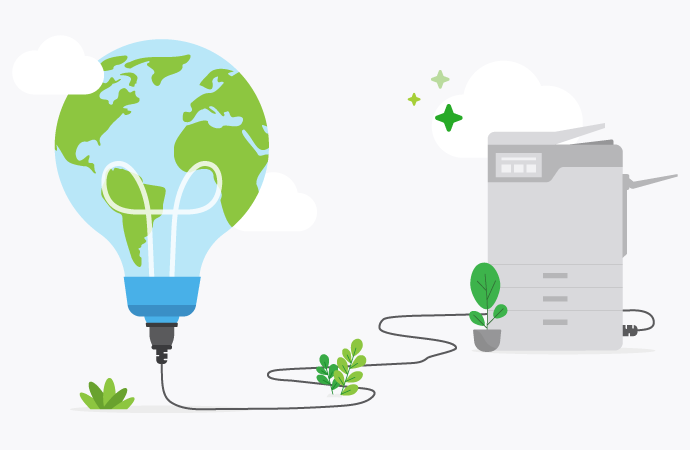Anyone else finding it harder to ignore that little wave of guilt that rolls in anytime you press print?
Whether you’re a member of the Sting or the Greta Thunberg generation, chances are you’ve heard the environmental call and are doing your best to work in a paperless way - and yet, sometimes you just have to print!
Thankfully the printing industry is heeding our eco-warrior cries for more sustainable printing. Here are six innovative sustainability trends that promise to help us minimize waste and conserve resources so we can reduce the environmental impact of each of those must-print jobs.
1: Bio-based inks and substrates
Bio-based inks and substrates are eco-friendly alternatives made from renewable resources such as soy, algae, and other plant-based materials. They’re replacing petroleum-based inks and as a result reducing the world’s reliance on fossil fuels.
Not only that, but the traditional ink production process creates air pollution as it releases toxic chemicals into the atmosphere. Bio-based ink alternatives are producing fewer volatile organic compounds (VOCs), which means lower environmental impact and, critically, a healthier working environment for a generation that isn’t accepting of anything less.
Read more about the environmental impact of traditional ink2: AI-powered print optimization
AI is revolutionizing the way printing processes are managed. AI algorithms can optimize print layouts for maximum efficiency and minimum paper waste, in an industry that sees 1 billion trees worth of paper thrown away in the US alone.
AI can even suggest more environmentally friendly paper options based on the print job, and energy efficient strategies thanks to tools that analyze data to predict and manage print demand.
Knowledge is power and businesses tapping into AI’s data capabilities are locking in less waste by ensuring that only the necessary amount of materials are used for each print job. It’s print technology with infinite potential and it’s already saving resources and proving to be a game-changer.
Read more about AI and print services3: Print integration with digital workflows
Integrating multiple pieces of software like JDF, XMF, API, Zaikio or Zapier is how the print industry is keeping up with increasing consumer demand. It’s also how we’re delivering tighter turnaround times and streamlining processes - and creating end-to-end connected digital workflows has had a positive impact on hitting sustainability targets too.
More digital and less (paper) documents means workplaces can be less dependent on paper, reduce their carbon footprint, and minimize their environmental impact.
Read more about print integration4: Energy-efficient printing technologies
The eco-friendly printing movement is grounded in energy-efficient print technologies. From modern printers designed with energy-saving features such as automatic sleep modes, reduced warm-up times, and lower power consumption, to printers now using advanced toner formulations that simply require less energy to fuse onto paper.
These technologies are integral to lowering energy bills and reducing carbon footprint, making them an essential part of an effective sustainable printing strategy.e
Read more about reducing your carbon footprint5: LED UV and thermal printing
LED UV and thermal printing technologies are helping businesses achieve modern-day sustainability goals while maintaining high-quality output. LED UV printing uses ultraviolet light (instead of heat or solvents) to cure or dry ink instantly.
A faster, cleaner process that significantly reduces energy consumption, while also enabling printed materials to be handled and processed faster for better productivity.
Direct thermal printing offers a chemical-free and energy-efficient alternative to conventional methods by using heat to transfer or produce images on heat-sensitive paper. It doesn’t require ink, toner, or ribbons, reducing the consumption of printing supplies and minimizing the waste generated from used cartridges and packaging.
LED UV printers emit fewer pollutants due to their energy efficiency and use of VOC-free inks, and thermal printers eliminate the need for harmful chemicals altogether. They both enjoy longer lifespans of LED UV printers and more durable output, resulting in less equipment replacement and less consumption.
Read more about eco-friendly printing6: Cloud-based print management solutions
A cloud-based print management system is more than a trend - we think it’s a way of life! With its ability to reduce the need for on-site servers, eliminating the associated energy consumption, cloud-based print management solutions are the cornerstone of any authentically eco-friendly printing strategy.
It also enables remote monitoring and management, and more efficient print policies for organizations looking to enforce company-wide sustainability practices.
Read more about cloud printingThe security benefits of sustainable print practices
Sustainable print solutions typically include data encryption and secure disposal options, adding an extra layer of protection to sensitive information. Secure print release and pull printing systems are another advantage as this new way of working ensures that documents are only printed when the user is present to collect them.
Proving that eco-friendly trends are as beneficial for the environment as they are for security, this combines reduced waste from unclaimed print jobs with the prevention of unauthorized access.
Read more about print securityChange is afoot for the printing industry in 2024, and we have great hopes that together we can reduce our printing footprint through tech-driven sustainability initiatives.




